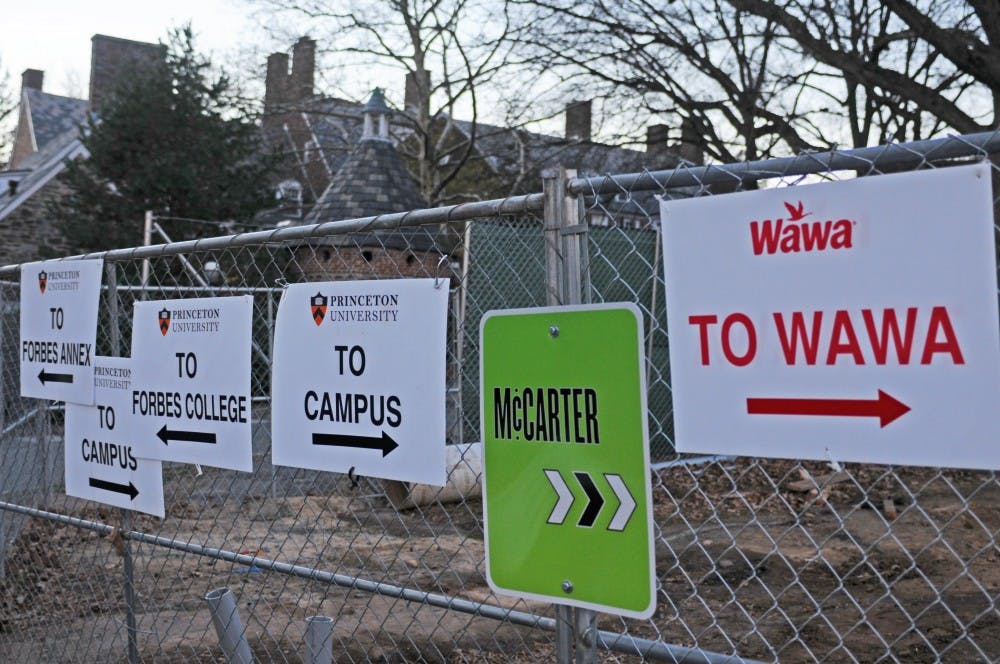The forthcoming Arts and Transit Center is supposed to bring Forbes into the heart of a new campus community, featuring new spaces for music, dance and theater classes, not to mention the construction of the most advanced WaWa in the world. However, in the process of fulfilling this ambition, a labyrinth of fencing and temporary pedestrian paths have taken root on the site, making the trek to Forbes not only taxing because of the distance but unpredictable, confusing and, quite often, terrifying. Half the time, you expect a sphinx to emerge to tell you a riddle, and the other half, you think Jack Nicholson is lurking behind a corner with an axe. But I digress. There are, in fact, several ways in which we can appreciate the construction maze to Forbes — and why it’s so much better than the boring offices and normal sidewalks that used to be on the same grounds.
1. The Maze is an adaptable, learning organism, demonstrating the feats of traffic engineering gone amok.
I’ve noticed this from the beginning. Every time I enter the construction maze to Forbes, it takes on a different configuration. As it turns out, since the commencement of construction in September, the Maze rearranges itself on a 37-hour cycle. Some may call it a defense mechanism — I call it genius. The Maze changes more frequently than an A.B. underclassman changes his major. Therefore, the Maze represents the general ability of a Princeton student to adapt to any situation, while also showcasing the possibilities of a very large University endowment and the indecisiveness of fickle traffic engineering.
2. The Maze improves Forbesian navigation skills.
It’s agreed on campus that people who live in Forbes have it tough. The most isolated from the other residential colleges, being in a different zip code, Forbesians must plan their days with laser-like precision and regularly cross streets with motorized vehicles. Some of them even live in a strange asylum-like structure called “the Annex.” Despite this, Forbesians have thrived, having built a dynamic campus community that not every outsider can fully understand. Now Forbesians face a new challenge — a tangled web of mysterious barbed-wire fences, mysterious signs that read “Train Station,” “WaWa,” and the elusive “Campus” — it’s undisputed that confusion comes with every turn.
Few have realized that these additional adverse conditions will instill a greater sense of direction in Forbesians, creating a generation of Forbesians with OA leader skills. Like Odysseus, a Forbesian returning to Forbes will face Polyphemus, Scylla and Charybdis in sequence, vanquishing all threats. A Forbesian’s return will herald a grand celebration and much feasting on chocolate fountains and Brie cheese. In effect, the Maze improves Forbes’ self-sufficiency and further alienates it from the majority of the University community, who will hear of the grand feasts and say, “Too far.”
3. It’s a challenge. And Princetonians are all about the challenge.
George Mallory, the first man to attempt to climb Mount Everest (he died), once was asked why he wanted to climb Mount Everest in the first place. His reply: “Because it’s there.”

Why would a non-Forbesian want to go to Forbes? Because there’s a confusing maze of construction that is endlessly frustrating and, well, confusing. The allure of the challenge, in the end, attracts to the Forbes dining hall the worthy fewwho alone will be able to understand their eccentric culture, where everyone knows each other’s name and the inhabitants sport red sweatshirts with the gigantic letter “F.”
Princeton students are all about the challenge. It was a challenge to be admitted, it is a challenge to succeed — in the grand scheme of things, what does it matter if you spend 15 to 3,000 minutes trying to access Forbes, the Wa or, God forbid, you actually have a train to catch? In the end, the construction maze is a Herculean quest. And Princetonians are up to the challenge.
To Conclude: The construction maze is an adaptable organism; it conditions future outdoorsmen; it further alienates Forbes; it will be gone in four years. No current undergraduate will experience the Arts and Transit Center in all of its epic glory. For us, the journey is the destination. Build a maze, and we will come.









